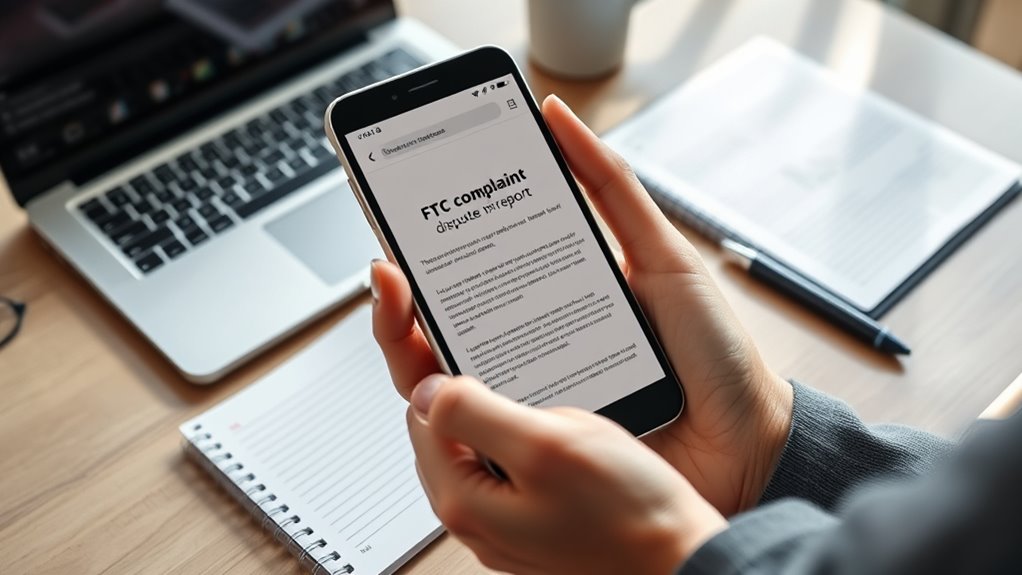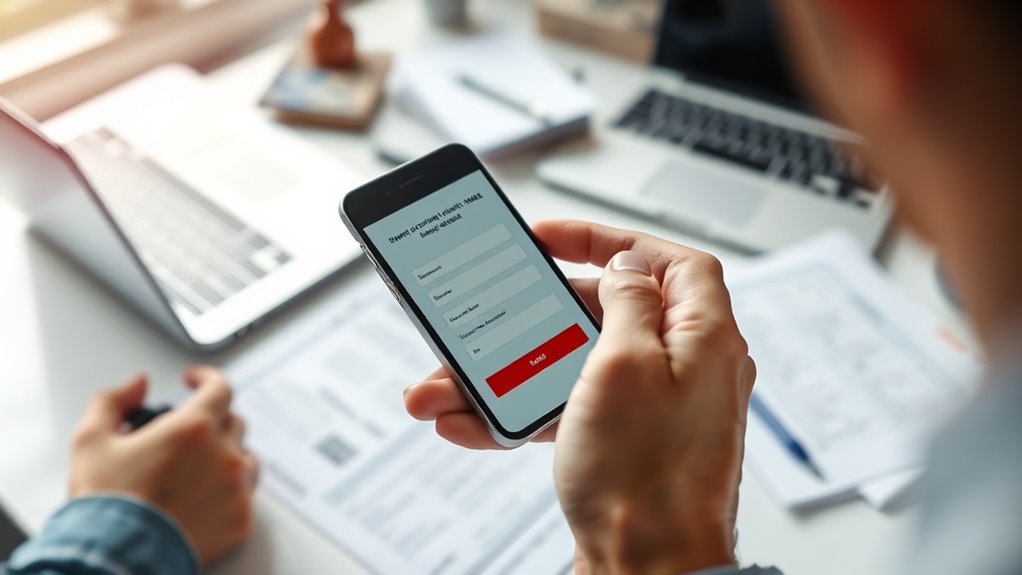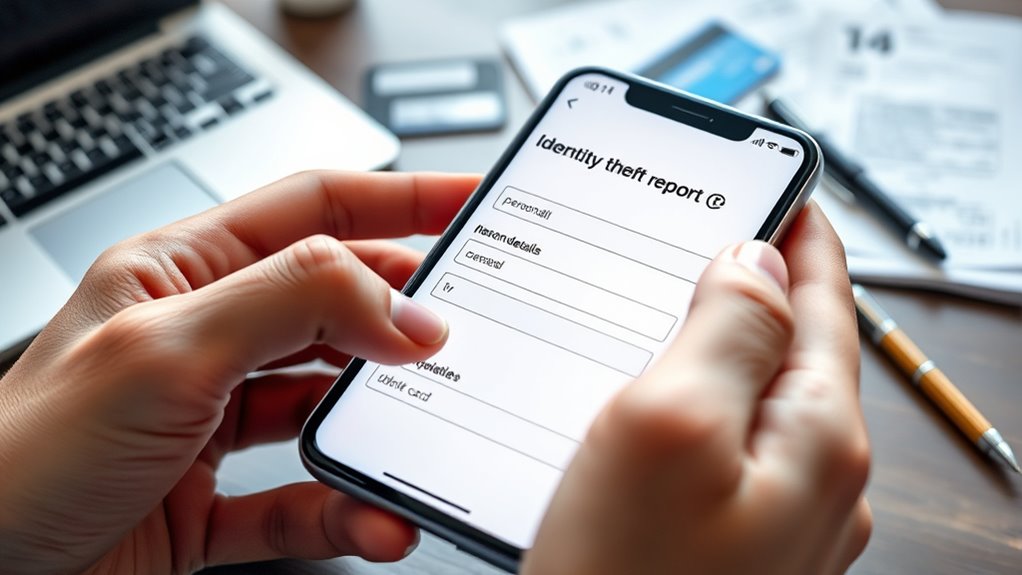To file an identity theft report and dispute charges, start by visiting IdentityTheft.gov to complete the FTC’s online affidavit and get an official report. Gather your ID, proof of address, and evidence of fraud. File a police report and provide copies of all documents to law enforcement. Contact your creditors with the FTC report and police memo to dispute unauthorized charges. Continue exploring these steps to learn how to protect yourself and prevent future theft.
Key Takeaways
- File an identity theft report with the FTC via IdentityTheft.gov, completing the affidavit and obtaining a case number.
- Gather documentation such as government-issued ID, proof of address, and evidence of the theft before reporting.
- Report the incident to local law enforcement with all supporting documents and request a police report.
- Dispute fraudulent charges and accounts by contacting creditors with the FTC affidavit and police report as proof.
- Monitor credit reports regularly, place fraud alerts or credit freezes, and update security measures to prevent further theft.
Gathering Essential Documentation for Reporting

When reporting identity theft, gathering the right documentation is crucial to support your case and expedite the process. First, obtain the FTC Identity Theft Affidavit from IdentityTheft.gov or the FTC complaint form. This document officially reports the theft and is essential for your case. Next, bring a government-issued photo ID, like a driver’s license or passport, to verify your identity. You’ll also need proof of your current address, such as utility bills or rental agreements. Collect any proof of the theft itself, including credit card statements, IRS notices, or other relevant documents showing fraudulent activity. Additionally, prepare the memo for law enforcement, which can help legitimize your report. Having these documents ready ensures a smoother process when filing reports or disputes. Understanding how to interpret contrast ratio and color accuracy can also help in identifying discrepancies in affected accounts or devices. Moreover, reviewing your credit reports regularly can help detect unauthorized activity early and prevent further damage. Staying informed about advances in AI in Education may also help you recognize suspicious digital activity related to your personal information. Being aware of recent market trends can sometimes provide clues to potential financial scams or identity theft schemes.
Steps to File an FTC Complaint Effectively

To file an FTC complaint effectively, start by visiting IdentityTheft.gov, the official online portal for reporting identity theft. Fill out the detailed complaint form, providing as much information as possible about the incident. Be specific about how your identity was stolen, which accounts are affected, and any suspicious activity you’ve noticed. After submitting, print and save the FTC Identity Theft Affidavit immediately, as you won’t be able to access it later. Record the complaint reference number for future follow-up. If you prefer, you can also call the FTC at 1-877-438-4338 to report the theft. Acting quickly and accurately guarantees your complaint is properly documented, helping authorities assist in resolving the issue efficiently. Understanding the importance of proper documentation is key to ensuring your case is prioritized and effectively handled. Additionally, maintaining detailed records of all related communications can strengthen your case, and keeping a detailed timeline can streamline the investigation process. Being aware of the importance of timely reporting can significantly impact the success of your recovery efforts. Ensuring you understand the role of law enforcement can further facilitate the recovery process and investigation.
How to Report the Crime to Local Authorities

Reporting the crime to local authorities is a crucial step in stopping the fraudulent activity and starting the investigation. Visit your local police station in person, bringing all necessary documentation, including your FTC affidavit, government-issued ID, proof of address, and evidence of the theft. Clearly explain the situation and provide any supporting documents to help law enforcement understand the scope of the crime. If the police are hesitant, show them the FTC memo to establish legitimacy. Request a copy of the police report; this document is essential for disputing unauthorized charges and working with creditors. If standard reporting isn’t accepted, you can file a “miscellaneous incidents” report. Prompt reporting helps authorities take swift action and increases your chances of recovering stolen assets. Understanding the importance of emotional support during this process can also help you stay resilient. Additionally, familiarize yourself with divorce laws if your case involves complex legal considerations related to identity theft and financial disputes. Being aware of state-specific procedures can further streamline your efforts in resolving the issue efficiently. Consulting with a qualified attorney experienced in financial disputes can provide personalized guidance tailored to your situation.
Disputing Unauthorized Charges and Accounts

After you’ve reported the theft to law enforcement and obtained the necessary documentation, the next step is to dispute any unauthorized charges and accounts. Contact each of your creditors and financial institutions directly. Provide them with your FTC identity theft affidavit and police report as proof. Follow their specific procedures for filing disputes, which often involve submitting dispute forms online, by mail, or over the phone. Monitor your credit reports regularly to spot any additional fraudulent activity. Keep detailed records of all communications, including dates, names, and responses. Stay persistent and follow up until the issues are resolved. For example, credit report monitoring can help you quickly identify any new fraudulent activity. Utilizing identity theft protection services can offer additional safeguards and alerts. Being aware of safe banking practices can help prevent further issues and protect your accounts. Incorporating wicks in candles techniques can help you understand the importance of proper wick placement for safety and efficiency. Using the hours of beauty stores in your area can help you find local stores that may offer assistance or resources. By acting swiftly, you can help limit the damage and restore your financial standing.
Additional Measures for Recovery and Prevention

Taking proactive steps is essential to both recover from identity theft and prevent future incidents. First, update all your online account passwords with strong, unique combinations. Enable two-factor authentication whenever possible to add extra security. Monitor your bank and credit card statements regularly for suspicious activity. Consider placing a fraud alert or credit freeze with credit bureaus to restrict access to your credit report. Keep detailed records of all communications and document any new suspicious activity. Avoid interacting further with the thief, and don’t share personal information unnecessarily. Follow guidance from authorities like the IRS and FTC carefully. Practicing vigilance in account monitoring can help detect fraud early and mitigate damage. Educating yourself about identity theft prevention strategies can further bolster your defenses. Being aware of common cybersecurity threats can also help you recognize and avoid potential scams. Staying informed about credit report monitoring options allows you to respond promptly to any unauthorized activity. By staying vigilant and taking these preventive measures, you reduce your risk of future theft and strengthen your financial security.
Frequently Asked Questions
How Long Does It Typically Take to Resolve an Identity Theft Case?
Resolving an identity theft case usually takes between a few months to over a year, depending on the complexity. You might experience delays if authorities need more information or if disputes with creditors are involved. Stay proactive by monitoring your accounts and maintaining communication with law enforcement, credit bureaus, and creditors. Patience is key, but consistent follow-up helps accelerate the process and ensures your case gets the attention it needs.
Can I File an Identity Theft Report Anonymously?
Think of your identity as a precious key—protecting it is crucial. You can file an identity theft report anonymously, but it’s not always recommended. When you report anonymously, authorities might struggle to build a complete picture, delaying resolution. If you choose to stay anonymous, use a trusted intermediary or legal advice to help safeguard your privacy, but be aware that providing your contact info often speeds up investigations and recovery.
What Should I Do if My Police Report Is Rejected?
If your police report gets rejected, don’t get discouraged. You should ask the officer or department for specific reasons why it was refused. Then, address any missing or incorrect information by providing additional documents or clarification. Consider visiting a different police station if necessary, and keep detailed records of your interactions. You can also file a report with other law enforcement agencies or consult a legal professional for guidance on next steps.
Are There Costs Associated With Disputing Fraudulent Charges?
Disputing fraudulent charges usually doesn’t cost you anything directly. Creditors and financial institutions generally handle disputes free of charge, especially when you provide the necessary documentation like an FTC affidavit or police report. However, be aware that some credit bureaus or services might charge for extra monitoring or reports. Stay vigilant, and always ask about any potential fees before engaging in dispute processes to avoid surprises.
How Do I Protect My Credit After Reporting Identity Theft?
You’re the captain steering your credit ship through stormy waters. To protect it, set up fraud alerts with credit bureaus, freeze your credit reports, and regularly review your accounts. Change passwords to lock out thieves, and stay vigilant for suspicious activity. Keep detailed records of all actions, and communicate with creditors promptly. By staying alert, you’re the lighthouse guiding your credit safely back to calm waters.
Conclusion
By taking these steps, you’re channeling your inner hero, like Perseus facing Medusa—facing the chaos head-on. With the right documentation, swift reporting, and proactive disputes, you can reclaim your identity and prevent future threats. Remember, in this battle against identity theft, you’re not alone; authorities and resources stand ready to support you. Stay vigilant, and turn your story from vulnerability into victory, forging your own myth of resilience.








